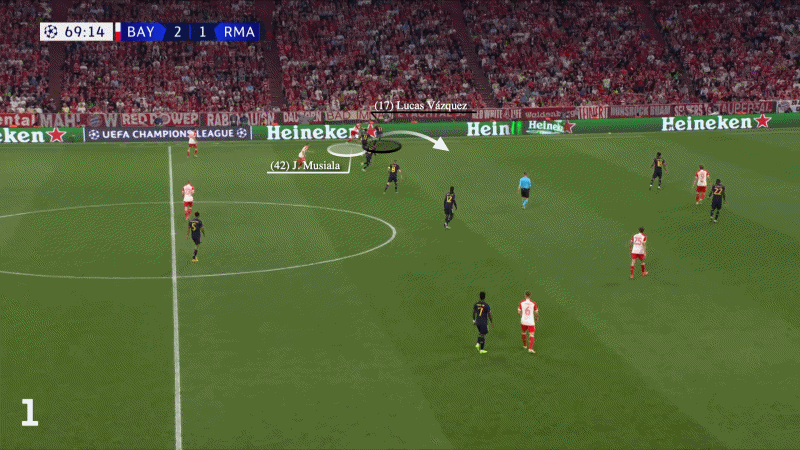With so much talent on show in Tuesday’s Champions League semi-final first leg between Bayern Munich and Real Madrid, a lot of the pre-game narrative was centred around individuals.
It was the battle of the star Englishmen — Harry Kane versus Jude Bellingham. It was Germany internationals Toni Kroos and Antonio Rudiger returning to their home nation. It was the departing Thomas Tuchel in a touchline battle of wits against the inveterate Carlo Ancelotti.
In many ways, two goals from Vinicius Junior meant that a spotlight was shone on a single player as Madrid took a 2-2 draw back to the Bernabeu for next Wednesday’s decider, but the overriding narrative was about Bayern’s team structure rather than a single individual.

GO DEEPER
The Briefing: Bayern 2 Real Madrid 2 - Advantage Ancelotti and Kroos for Ballon d'Or?
While his Bayern side typically play in a 4-4-2 out of possession, Tuchel elected to start the game with a rare 4-2-2-2 formation when they were on the ball. The midfield pair of Konrad Laimer and Leon Goretzka sat behind Leroy Sane and Jamal Musiala as narrow No 10s, with Kane and Thomas Muller essentially playing as split strikers.
This approach was clear within the first few minutes…

… although it is perhaps starker here, with 12 minutes on the clock.

The left-footed Sane has predominantly played on the right wing for Bayern this season, but his versatility to play on either flank meant that Tuchel had two wide forwards playing on their naturally dominant foot — with the right-footed Musiala on the opposite wing.
The pair would often roll inside, which allowed the full-backs to play high and, at times, form a staggered back six against Madrid’s back line. The approach was overwhelmingly successful in the opening 20 minutes, as Bayern registered six shots (to Madrid’s zero) and 61 touches in the final third (to Madrid’s 14), and they suffocated their opponents for long periods of the first half.
On the one side, Musiala and Muller would exchange neat, intricate passes in tight areas in the right half-space…

… while Kane and Sane would look for the path of least resistance in playing direct, with the England captain dropping in and exploiting the latter’s pace as often as possible.

The irony is not lost on anyone that Tuchel’s use of a 4-2-2-2 is a system that is synonymous with Red Bull football.
With the imminent announcement that Red Bull godfather Ralf Rangnick will replace Tuchel in the Bayern dugout this summer, last night gave the home fans a look at the tactical set-up they are likely to see next season.
Advertisement
However, despite their dominance in the first half, Bayern were sucker-punched by a well-worked goal scored by Vinicius Jr, and they did lack a central penalty-box presence at times. Muller was typically elusive in playing between left centre-back Nacho and left-back Ferland Mendy — while Kane drifted to left-sided areas to provide for Sane — but Bayern failed to capitalise, with too many clear-cut chances spurned, and went into half-time trailing 1-0.
“We started very well. We wanted two strikers and two wingers in the first half and we wanted to support with full-backs,” Tuchel told The Athletic after the game.
“We were strong in the beginning of the match but then, when we conceded, we lost a bit of rhythm and confidence to play through the gaps and lost the speed in our passing. So in the second half, we changed and had more aggressive wingers in wider positions and tried to be more aggressive in our passing with more dribbles from out to in.”

GO DEEPER
Vinicius Jr is Real Madrid's transformative big-stage player - with a twist
Tuchel changed to a more familiar 4-2-3-1 in that second half, with Sane and Musiala switching flanks and Kane providing a better focal point behind Muller — who was frequently enticing the Madrid centre-backs into following him into deeper, or wide, areas.
Returning to inverted wingers was immediately effective, as it proved for Bayern’s equaliser.
Laimer’s pass to Sane saw the German hugging the touchline to stretch the pitch. As he receives the ball, Joshua Kimmich overlaps as Sane makes the out-to-in run directly towards the outnumbered Mendy. Sane cuts in to rifle the ball in at the near post.
It is a rather simple goal overall, but one that could not have been scored in the first half, given Bayern’s structure.

On the other side, Musiala’s typically sleek ball-carrying was maximised when he was able to come inside onto his stronger foot. His seven take-ons were as many as the rest of his team-mates combined across the whole game, but the second half in particular saw him torment right-back Lucas Vazquez.
The best example of that was Musiala’s driving run into the box after 55 minutes when he was caught by Vazquez to earn his side a penalty, which was scored by Kane to put Bayern in front. That direct Musiala running was a feature of the second half. Vazquez tried to get tight but instead found he was chasing the youngster’s shadow at times.

So, two goals scored as a consequence of the changes made after half-time. In truth, Bayern will be disappointed that they didn’t capitalise more on their dominance in both halves, but they can be encouraged by their attacking versatility as they look to punish Madrid in the return leg next week.
“I was happy with the reaction because we played with more freedom and the game was more aggressive offensively which helped us step up defensively,” Tuchel said.
European football suits Bayern. Not just historically, with their six European Cup/Champions League wins (only Madrid and AC Milan have more), but specifically this season. In the domestic competitions, Tuchel’s side have been frustrated by opponents playing deep blocks and looking to condense any spaces that Bayern could exploit.
In the Champions League, they are unshackled, more expressive and seemingly able to find more space against sides more willing to go toe-to-toe with them.
Sometimes, like on Tuesday, they just need one tactical tweak to unleash the best versions of themselves.

GO DEEPER
Bayern Munich reminded everyone - and themselves - who they are
(Photo: Kevin Voigt/Getty Images)
